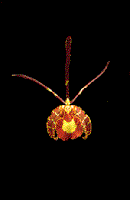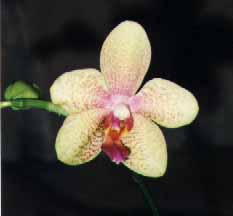 |
Phalaenopsis Barbara Moler ' Gerdie' x
P. Livingston's Dazzle 'Leucadia'
Pink blush on an almost fluorescent yellow-green background
|
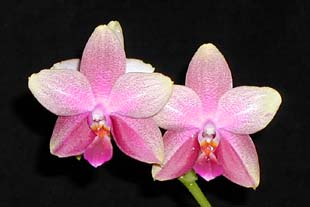 |
Phal.
Sweet Memory 'Bubbles'
Along with heavy substance
and spectacular shading, this Phal.violacea hybrid has wonderful fragrance.
|
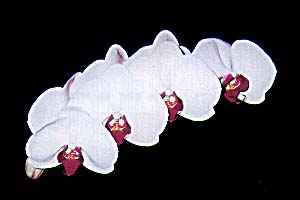 |
Phal. Lucky Lady 'Jamie' x Dts. City Girl 'Madonna' |
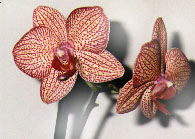 |
P. Brother
Girl 'Brother'
Deep gold background with red veins. Dramatic and
rich.
|
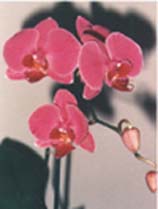 |
Doritanopsis Happy Valentine x Phal. New Eagle
Intense purple-red.
|
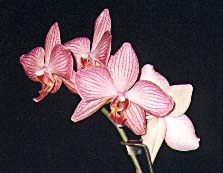 |
Phal.
Suziana Wijanto 'East Bay' x Ana Hernandez 'Pamela's Stripe'
Rather unusual star shape and
dramitic striping makes this one rather special.
|
 |
Phal.
Cathy Fogarty 'Tomato Red'
There is no true red pigment in Phals, but breeders
are getting very close, and this has a wonderful soft red color that is
really a light purple overlaid on a gold bacground.
|
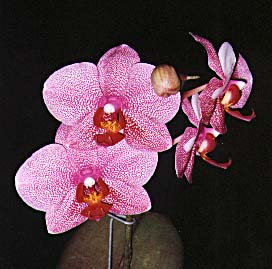 |
Paifang's
Auckland 'Ontario' x Carmela's Spot 'Pat'
Large, flat, bright spotted flowers.
|
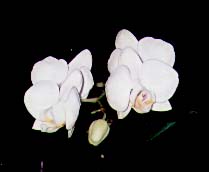 |
Phal.
amabalis var formosanum
These flowers are dainty and
delicate looking. The spike has a tendency to branch, making for a beautiful
display.
|
 |
Psychopsis (Oncidium) papilio
This plant produces one flower at a time over a period of
months and even years, on a wire-like spike that can be 4' (120 cm) or
more. Don't cut the spike on these until it dies all the way back - it
will re-bloom. Also, do not over-water- it likes to be on the dry side.
|
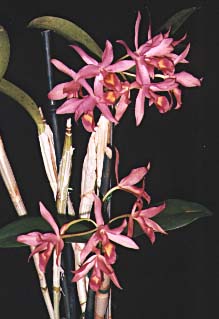 |
C.
guatamalensis
This is actually not a species,
but rather a natural hybrid between C. aurantiaca and C. skinerii. It
seems to grow better inside, with bright light. It had dead-looking sheaths,
which I had trimmed after they were dry for 6 months for one and about
a year for the other. Much to my surprise, I found buds emerging about
2 months ago! I am glad that I did not cut any more!. Because they did
not have a full sheath to lend strength to the raecemes, I did have to
provide some support - otherwise, no harm done by the trimming, and may
have prevented rot.
|
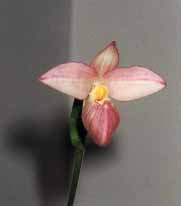 |
Phragmipedium Hanne-
Popow
This plant produces flowers successively. The flower
falls off while still perfectly formed (and will survive a few more days
in water), then another one opens within a week or so. I have found that
while this plant will grow outside in the summer, it seems happier indoors
with the Phalaenopsis, as long as I keep it damp.
|
| |
|
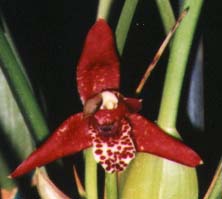 |
Maxillaria tenufolia
These little flowers have a strong fragrance of coconut.
|
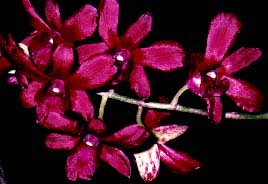 |
Den. Bobby Mesina 'Kamiya' x Imelda Romouldes
The picture does not do the color justice - this is
a very dark, velvelty purple dendrobium phalaenopsis hybrid. It grows
in a sunny window.
|
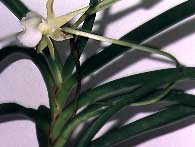 |
Angraecum Longiscott 'Hihimanu'
A member of this genus, native to Madagascar, served to support
Darwin's theory of natural selection. The flower has a distinctive long
spur, and Darwin predicted that it was pollinated by a moth with a very
long tongue. 20 years later, that moth was discovered, and Darwin's prediction
proven correct. The flowers are fragrant at night.
|
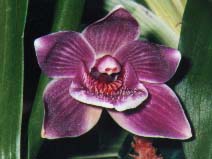 |
Pescatoranthes
Star Sapphire (Pes. lehmannii x Psnth. Painted lady)
This beauty, with its very textured lip and blue-purple color,
seems to like to be very damp. It grows in sphagnum, in a hanging pot.
It has been blooming on and off since I got it in February. It is has
put out new growth, and new growths have bloomed several times since it
came to live at my house.
|
 |
Phragmapedium
Sedenii (?)
Identification of this plant is in doubt - it did
not have a tag. It came from the collection of the late Gordon Clayton,
who grew wonderful Paphs and Phrags, and was a beautiful human being as
well. I hope to be able to do justice to this plant. Its beauty and vigor
are not in doubt at all. It produces one flower after another. While some
Phrags are marginally OK outside in the winter, this one is definitely
better off inside. Since it does not need alot of light, I grow it inside
with the Phals.
|
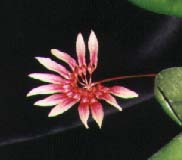 |
Cirropetalum
makoyanum
Cirropetalums are actually
part of the genus Bulbophylum. They do well on mounts, or in wood baskets
(where this one lives). The flowers only last for a few days, but they
send out new ones every few months.
|
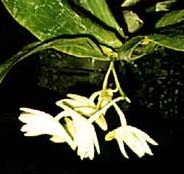 |
Dendrobium
platycaulon
This Dendrobium has strange,
flattened pseudobulbs. It seems to grow well with the Phals. The flowers
hang under the leaves. It bloomed in October, then put out a completely
new set of flowers in late December.
|
| |
|
![]()
![]()
